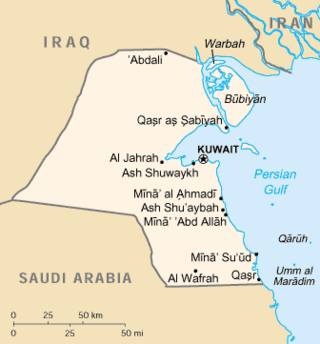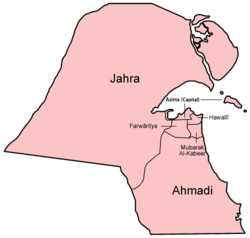Kuwait
sovereign state in Western Asia From Wikipedia, the free encyclopedia
Remove ads
Kuwait (Arabic: الكويت) is a small Arab country (about 17,819 square kilometers) in the Middle East.




Kuwait is the most socially progressive country in the Gulf region. It has a small and rich economy. It has about 96 billion barrels of crude oil reserves. Crude oil reserves are the oil that is still under the ground and has not yet been cleaned up. Kuwait has 10% of all of the oil reserves in the world. The country makes a lot of money by selling oil. This money is almost half of all the money the country makes. The oil money is also 95% of the money made by selling things to different countries (people call that exports). Also, the oil money is 80% of the money the government makes. Kuwait is now talking with oil companies of other countries to make oil fields in the northern part of the country.
Kuwait's weather makes farming hard (too little rain). Instead of farming, the country catches fish and buys food from other countries. About 75% of the country's water to drink has to be distilled (have the salt removed) or purchased from other countries.
In 1990, Iraq invaded (brought an army in to fight against) Kuwait. This started the first Gulf War. Kuwait's official religion is Islam, although 15% of its population are Christian or Hindu. Arabic is mostly spoken in Kuwait but English is widespread among Kuwaitis (residents of Kuwait). Kuwait is one of the few nations that has education for every age.
Remove ads
Demographics
As of 2023, Kuwait has a population of 4.82 million people of which 1.53 million are Kuwaiti citizens while the remaining 3.29 million are foreign nationals from over 100 countries.[7] Of the total population of Kuwait, only 31% are Kuwaitis while around 69% are Non-Kuwaitis.[8] Indians are the biggest Expat community in Kuwait making 21% of the population followed by Egyptians who are 13% of the population.[8]
Population (in thousands) for 2004: 2595. CBR (per 1000) for 2004: 19.4. CDR (per 1000). Growth rate (%) for 2004: 1.9. For 1992-2002: 2.1. The total fertility rate for 2002 is 2.7. Percent population living in urban areas is 96.2 in 2003. Per capita gross national income ($) in 2002: 612. Population density (per square kilometer) in 2000: 107.4. Infant mortality rate (per 1000) for 2005: 9.95. Adult literacy rate: 85%. Female literacy rate: 81% as of 2002.
Remove ads
Governorates
Kuwait is divided into 6 governorates. The governorates are divided into districts, And the establishment of the governorates of Kuwait dates back to the Emiri Decree No. 6 issued in 1962, which divided Kuwait into three governorates: the Capital Governorate, Hawalli Governorate and Al-Ahmadi Governorate. The decree clarified the work of the governor, his subordination of the governor to the Ministry of Interior, and his responsibility towards security, provided that the Ministry of Interior issues the necessary decisions to indicate the limits of the governor's jurisdiction. There have been some changes regarding the governorates of Kuwait, which we summarize as follows:
. On November 14, 1979: Some provisions of the administrative division decree were amended so that a fourth governorate, Al-Jahra Governorate, was added.
. On October 12, 1988: The first article of the article was amended to divide Kuwait into five governorates by adding Al-Farwaniyah Governorate.
. On November 27, 1999: Emiri Decree No. 290 was issued to add a sixth governorate, Mubarak Al-Kabeer Governorate.
Thus, Kuwait has become administratively divided into six governorates, each affiliated with several regions. Warba Island and Bubiyan Island belong to the Jahra Governorate, while the rest of the islands belong to the Capital Governorate.
Remove ads
Related pages
References
Wikiwand - on
Seamless Wikipedia browsing. On steroids.
Remove ads





